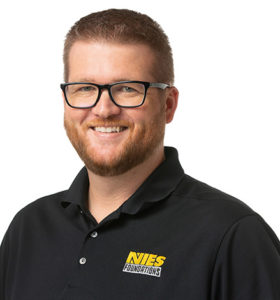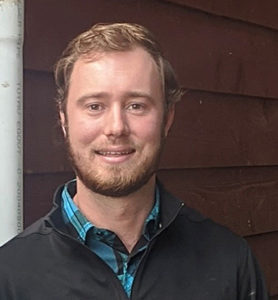Is Your Company’s Practice to Plan for Top Employee Retention?
Español | Translation Provided by the CFA

By Bill Humbert, RecruiterGuy.com
When your company is lucky, employee retention simply happens. However, there is never really a “simply happens.” Obviously, your company is operating in a manner that retains your best employees. Congratulations!
Over the past few weeks, I have spoken with several of the CFA member companies. A couple of company executives told me that they are focusing on the retention of their employees currently and seeing some positive results.
Why Is Employee Retention Important?
Many of you, when you were new to concrete construction, were driven to learn and succeed. When I was 18, I worked at a Triangle Pacific Truss plant in the yard during the summer between college semesters. My job was to ensure that the saw man received the correct lumber on his rollers to cut at the correct angles depending on the truss design. We planned the day on three priorities:
- Rush orders
- Large orders
- Small orders
We knew what orders needed to be processed during that day. I would plan the use of a tow motor to bring the lifts of lumber so the rollers would be filled as required.
As I learned the process, I was able to plan my day in such a way that enabled my supervisors to use me for creating house packages between cuts. In short, I was motivated to succeed for my manager and my team. This motivation helped me anticipate the company’s needs ahead of time, before they were expressed.
Since you are a founder or leader of a concrete construction firm, I believe that you were motivated to learn and anticipate needs ahead of time, too.
Isn’t a motivated laborer a person you want to retain?
Retention is important because every person you retain is one you will not have to recruit and train in the future. More importantly, they may grow to be one of your leaders, possibly a talented estimator. How long does it take for your organization to bring a new, raw laborer up to speed on your concrete team? This training is a cost of doing business, and it can be minimized by retaining more employees.
Would You Like to Know a Secret About Job Seekers?
Since I coach people in their career searches during slow recruiting periods, they tell me their secrets. One important secret is that they HATE looking for a good job with a great company. They hope that they land with a company where they can work for the balance of their career—much like many of their fathers.
How important is this secret? If your company has a program in place where deserving employees can grow in responsibility and income, you are taking the first big step in the retention of top performers.
What Is the Secret Behind Great Retention Programs?
Consistency.
Well, that is simple—except when it is not. Dealing with human beings can be difficult because we all have personal lives with differing needs. This includes your foremen. Build a retention program that incorporates consistency so everyone knows what they need to accomplish to reach the next level. Some workers will grow quickly. Other workers will find their level of comfort and stay there, like a worker who is content to be great at finishing slabs (almost like it is their art). They may not be interested in learning new skills because they are proud of their work on slabs.
Have you ever had a laborer who was great until you gave them just a little more responsibility than they were comfortable with? When I was a construction superintendent on the Pinnacle Garden Apartment and Townhouse project in NE Washington, D.C., one of my laborers was JW (not his real name). It was an unusual project because all six of my laborers came from within four blocks of our project. The surrounding apartment buildings and row houses were old. Many of the surrounding buildings needed repair, but the landlords were not willing to improve them. Most of my laborers did not finish school. However, most laborers took pride in their work.
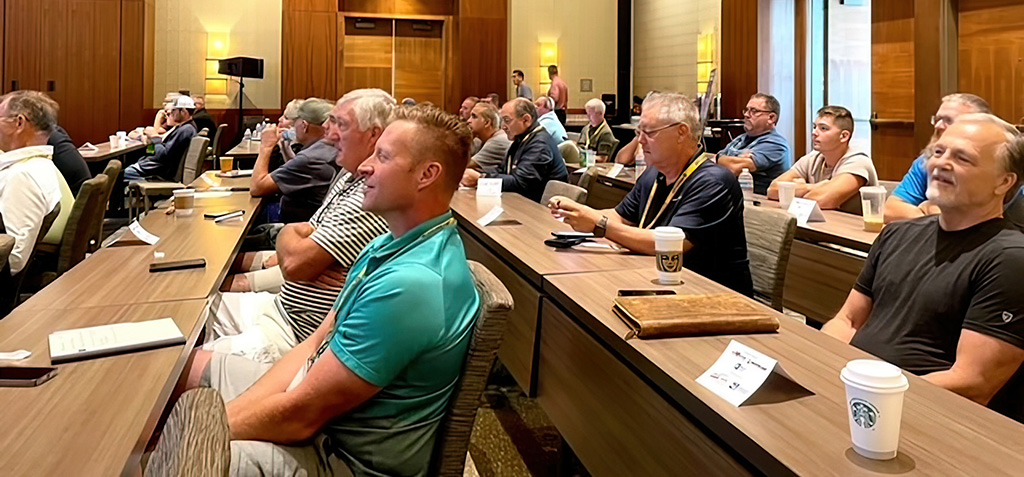
This was Section 8 housing in DC, so we were required to pay Davis-Bacon wages. In 1978, we paid our laborers $10.78 per hour. JW was my most skilled and dependable laborer—until I gave him too much responsibility. Then he went on a binge for a week. People need to be treated differently according to their abilities and their mental capacity. Today, the term that describes hiring people with differing mental limits is neurodiversity. JW is a great example of someone who excels at their job while being limited in their ability to grow. As a superintendent, I quickly learned JW’s limits—and accepted them. I have fond memories of JW and his work ethic.
Some of the executives with whom I spoke discussed how they created training for new laborers. Initially, the laborers learned important functional and safety skills. Once they achieved those goals, they were given recognition and a raise. Some people are driven more by positive recognition than money. I recommend that you read Drive: The Surprising Truth About What Motivates Us by Daniel Pink. After you read this book, you may decide that it is required reading for all your leaders. Understanding the difference between intrinsic motivation and extrinsic motivation is key to managing and retaining employees.
Create a growth program with specific, achievable goals for each level. Initially, the goals for new laborers should be simple, and once achieved, they should earn a small raise. As the training grows in difficulty, it will take longer to achieve the next level with appropriate recognition and wage increase. Some laborers will join your company at higher levels of experience. In this case, practice consistency by testing them through your process and determining where they belong in your training program. Most quality concrete construction companies are proud of how their processes differentiate them from other concrete companies.
Having a growth program conditions your employees to set and achieve goals from their first day on the job. By definition, a goal-setting and goal-achieving employee is an engaged employee. Engaged employees become retained employees.
Talent Retention Requires Foreman and Manager Training
It is one thing to know the technical aspects of a job (proper concrete reinforcement, pouring, finishing, curing, and workplace safety, for example), but coaching a team member is another important and very different thing.
How well have your foremen and superintendents been trained in proper management skills? As a leading talent attraction consultant, I agree with the following statement: “Workers leave managers, not their companies.”
Do you have a leader whose staff turns over often? They may be knowledgeable about the concrete business and yet costing your company by losing top talent. Of course, they will blame everything else—the location of the jobsite, the work, the weather, other subcontractors, etc.
The converse is true. Many times, I attempted to recruit a person from a company, and they informed me that they would not leave their manager. In one case, my client would have paid them 20% higher wages.
A foreman or project manager with good people skills will create a crew who is loyal to them—and to each other. As a concrete construction company leader, you will find that these leaders will retain their (your) employees. Retained teams are more efficient teams and more profitable teams.
¿Es práctica de su compañía planificar para retener a los mejores empleados?
English | Translation Provided by the CFA

Cuando una compañía es afortunada, la retención de los empleados es algo que simplemente sucede. Sin embargo, nunca existe realmente un “simplemente sucede”. Obviamente, su compañía está operando en una manera que retiene a sus mejores empleados. ¡Felicitaciones!
En las últimas semanas, he hablado con varias de las compañías miembros de la CFA. Un par de ejecutivos de compañías me dijeron que se están enfocando en la retención de sus empleados actualmente y buscan algunos resultados positivos.
¿Por qué es importante la retención de empleados?
Muchos de ustedes, cuando eran nuevos en la construcción de concreto, fueron obligados a aprender y tener éxito. Cuando tenía 18 años, trabajé en una planta de Triangle Pacific Truss en el aserradero durante el verano entre los semestres de la universidad. Mi trabajo era asegurar que el encargado de la sierra recibiera la madera correcta en sus rodillos para cortar a los ángulos correctos dependiendo del diseño del armazón. Planificamos el día con tres prioridades:
- Pedidos rápidos
- Pedidos grandes
- Pedidos pequeños
Sabíamos qué pedidos debían procesarse durante ese día. Planificaba el uso de un remolcador para llevar los levantamientos de madera de modo que los rodillos se llenaran según fuera necesario.
A medida que aprendí el proceso, pude planificar mi día de tal manera que permitía a mis supervisores usarme para crear paquetes para casas entre los cortes. En resumen, mi gerente y mi equipo me motivaron a tener éxito. Esta motivación me ayudó a anticipar las necesidades de la compañía por adelantado, antes de que las expresaran.
Debido a que ustedes son fundadores o líderes de empresas de construcción de concreto, creo que también fueron motivados a aprender y anticipar las necesidades antes de tiempo.
¿No es un trabajador motivado una persona que quisieran retener?
La retención es importante porque cada persona que retiene es una que no deberá contratar y capacitar en el futuro. Pero más importante aún, puede crecer para ser uno de sus líderes y posiblemente un estimador talentoso. ¿Cuánto tiempo tarda su organización en capacitar a un empleado nuevo y sin experiencia para que se trabaje bien con su equipo de concreto? Esta capacitación es un costo de hacer negocios y puede minimizarse al retener más empleados.
¿Le gustaría conocer un secreto acerca de los solicitantes de empleo?
Debido a que asesoro a las personas en sus búsquedas de carrera profesional durante los periodos de bajo reclutamiento, ellos me cuentan sus secretos. Un secreto importante es que ODIAN buscar un buen empleo con una compañía grande. Esperan llegar a una compañía donde puedan trabajar para equilibrar su carrera profesional, muy parecido a como lo hicieron sus padres.
¿Qué tan importante es este secreto? Si su compañía tiene un programa implementado donde los empleados que lo merezcan pueden crecer en responsabilidad e ingresos, usted está tomando el primer paso importante para la retención de empleados con el mejor desempeño.
¿Cuál es el secreto detrás de los programas excelentes de retención?
La consistencia.
Bueno, eso es sencillo, excepto cuando no lo es. Tratar con seres humanos puede ser difícil porque todos tenemos vidas personales con necesidades diferentes. Esto incluye sus jefes de obra. Desarrolle un programa de retención que incorpore la consistencia de modo que todos sepan qué es lo que deben lograr para alcanzar el siguiente nivel. Algunos trabajadores crecerán rápidamente. Otros trabajadores encontrarán su nivel de comodidad y permanecerán ahí, como un trabajador que está contento con ser muy bueno en acabar losas (casi como si fuera su forma de crear arte). Podría no estar interesado en aprender nuevas destrezas porque está orgulloso de su trabajo con las losas.
¿Alguna vez tuvo a un trabajador que era excelente hasta que le dio un poco más de responsabilidad con la que se sentía cómodo? Cuando era un superintendente de construcción en el proyecto Pinnacle Garden Apartment and Townhouse en el NE de Washington, D.C., uno de mis trabajadores era JW (no es su nombre real). Era un proyecto inusual porque seis de mis trabajadores provenían dentro de las cuatro cuadras de nuestro proyecto. Los edificios de apartamentos circundantes y las casas en hileras eran viejos. Muchos de los edificios circundantes necesitaban reparaciones, pero los arrendadores no estaban dispuestos a mejorarlos. La mayoría de mis trabajadores no terminaron la escuela. Sin embargo, la mayoría de los trabajadores se enorgullecían de su trabajo.

Este proyecto caía bajo viviendas de la Sección 8 en D.C., así que nos pedían pagar salarios Davis-Bacon. En 1978, pagábamos a nuestros trabajadores $10.78 por hora. JW era uno de mis trabajadores con más destreza y confiable, hasta que le di demasiada responsabilidad. Luego se dio un atracón por una semana. Las personas necesitan ser tratadas de manera diferente según sus habilidades y su capacidad mental. Actualmente, el término que describe la contratación de personas con límites mentales diferentes es neurodiversidad. JW es un gran ejemplo de alguien que sobresale en su trabajo al tiempo que tiene un límite en sus habilidades para crecer. Como superintendente, aprendí rápidamente los límites de JW y los acepté. Tengo recuerdos agradables de JW y su ética de trabajo.
Algunos de los ejecutivos con quienes hablé, mencionaron cómo crearon la capacitación para nuevos trabajadores. Inicialmente, los trabajadores aprendieron destrezas funcionales y de seguridad importantes. Una vez que alcanzaron estos objetivos, se les dio reconocimiento y un aumento. Algunas personas fueron motivadas más por el reconocimiento positivo que por el dinero. Recomiendo leer el libro Drive: The Surprising Truth About What Motivates Us (Impulso: la sorprendente verdad sobre qué nos motiva) de Daniel Pink. Después de leer este libro, pueden decidir si debiera ser una lectura obligatoria para todos sus líderes. Entender la diferencia entre motivación intrínseca y motivación extrínseca es la clave para manejar y retener a los empleados.
Creen un programa de crecimiento con objetivos específicos y alcanzables para cada nivel. Inicialmente, los objetivos de los trabajadores nuevos deben ser sencillos y, una vez que se alcancen, deben obtener un aumento pequeño. A medida que la capacitación crece en cuanto a dificultad, tomará más tiempo alcanzar el siguiente nivel con el reconocimiento y el aumento de sueldo apropiados. Algunos trabajadores se unirán a su compañía con niveles más altos de experiencia. En este caso, practique la consistencia al probarlos a lo largo de su proceso y determinar dónde pertenecen en su programa de capacitación. La mayoría de las compañías de construcción de concreto de calidad están orgullosas de cómo sus procesos las diferencian de otras compañías de concreto.
Tener un programa de crecimiento acondiciona a sus empleados a establecer y alcanzar sus objetivos desde su primer día en el empleo. Por definición, un empleado que se establece objetivos y logra objetivos es un empleado comprometido. Los empleados comprometidos se convierten en empleados retenidos.
La retención de talento requiere capacitar a los jefes de obra y gerentes
Una cosa es conocer los aspectos técnicos de un trabajo (el refuerzo, vertido, acabado, curado apropiados del concreto y la seguridad en el lugar de trabajo, por ejemplo), pero entrenar a un miembro del equipo es otra cosa importante y muy diferente.
¿Qué tan bien han sido capacitados sus jefes de obra y superintendentes en destrezas de liderazgo? Como un consultor líder en atracción de talento, estoy de acuerdo con la siguiente afirmación: “Los trabajadores abandonan a los gerentes, no a las compañías”.
¿Tiene un líder cuyo personal tiene una alta tasa de rotación? Es posible que tenga mucho conocimiento sobre el negocio del concreto, pero aun así le cuesta a su compañía perder talentos importantes. Por supuesto, el líder echará la culpa a cualquier cosa como la ubicación del sitio de la obra, el trabajo, el clima, otros subcontratistas, etc.
Lo contrario es cierto. Muchas veces, intenté contratar a una persona de una compañía y me informó que no dejaría a su gerente. En otro caso, mi cliente hubiera pagado a la persona un 20% más de salario.
Un jefe de obra o gerente de proyecto con buenas habilidades sociales crearán una cuadrilla que sentirá lealtad hacia ellos y sus compañeros de trabajo. Como líderes de compañías de construcción de concreto encontrarán que estos líderes retendrán a los empleados. Los equipos retenidos son equipos más eficientes y rentables.

NEW MEMBER SPOTLIGHT
Curtis Cowgill
Contractor member, President of Nies Foundations
Joining the CFA was a no-brainer for me. Since I’m new to the foundation industry, I was looking for a professional organization that I could be a part of to learn best practices from experienced industry professionals. I’ve found what I was looking for in the CFA! The monthly best practices calls have been an excellent resource for connecting with other business leaders in this industry and building a network of people dealing with the same issues. I would highly recommend that anyone in the industry, whether you are new or very experienced, join the CFA.
_____________________________________
Cory Deyell
National Associate member. DMX Plastics Limited.
DMX chose to join CFA because of the great reputation the association has in the concrete forming industry and for the networking opportunities to further grow our relationships. Our Foundation Wrap and Drain Boards are the next products in the building process to be installed after the walls are formed for waterproofing which makes the CFA a natural fit for us and our product lineup. We believe in having strong relationships with the concrete formers so that we can work together and ensure that customers will always receive the best protected foundations in the market. Our goal is to work and grow with CFA by partnering with the best formers in the United States, to further teach the industry about the benefits of our products and show them why the majority of large builders and formers in Canada will only trust their foundations to be wrapped with DMX.
Foundation Contractor’s Night
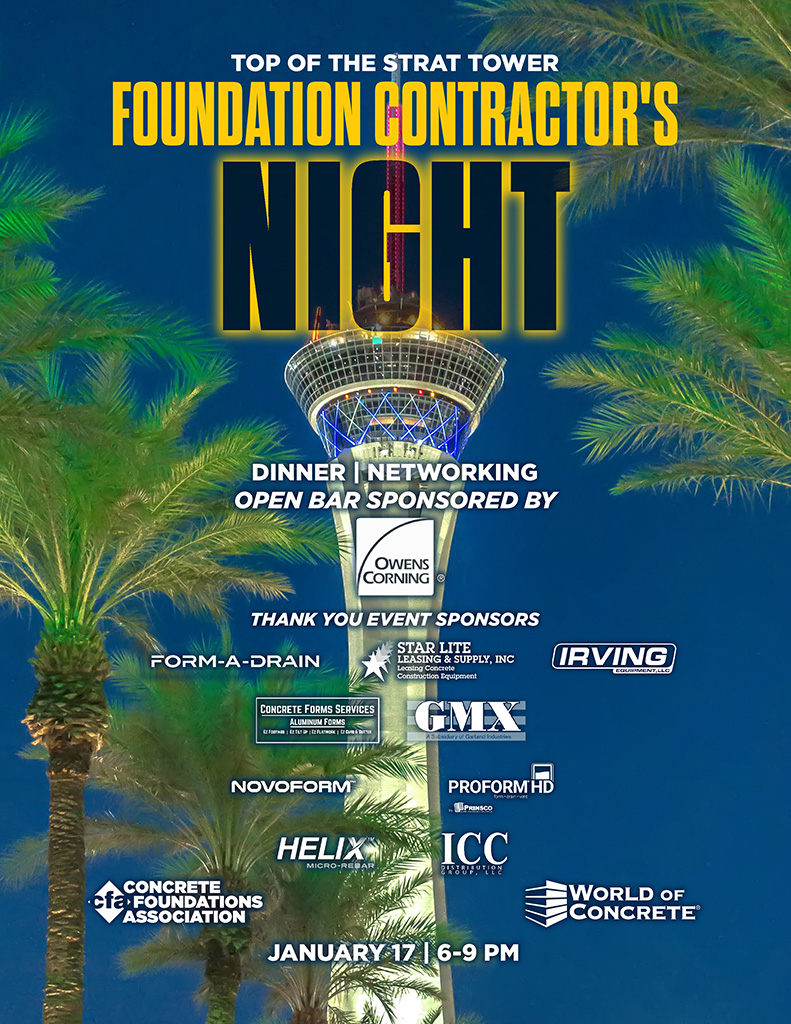
2022 PROJECTS OF THE YEAR
Español | Translation Provided by the CFA
SETTING A CULTURE OF PRIDE
The North American landscape continues to hide the most creative and challenging concrete installations each year. Now in its 23rd year, this program continues with its vision to give voice and expression to the great work completed every day throughout the markets that serve, support, and establish the art and science of residential construction. Companies across membership have expressed the value of having projects be submitted to an awards program. It honors the crews involved and instills pride in them for their achievement. When selected as one of the unique projects in a given class, these companies recognize the importance of memorializing their accomplishments and sharing their appreciation with the customers and partners who trusted them to deliver on the challenge.
In early 2022, Association members were once again invited to consider projects from their portfolios they felt represent exceptional craftsmanship and construction quality, unusual achievement, project complexity, and integration of advancing technology to set new standards. These criteria are not often thought about in an industry where the finished product is quickly covered up as it is built upon. Yet, companies on the leading edge understand the value of looking closely to recognize the quality solutions produced in the field for the work requested by the customer, specified by designers, and commissioned by builders.
What does it take to submit a project? The major consideration involves planning, as it takes both the ability to describe requirements and results as well as photographic or video documentation of the performance. With these in hand, any company can take this opportunity to advance their company culture and contribute to industry advancement.
So, without further delay, the Concrete Foundations Association publishes the top achievements in concrete projects for 2022—the CFA Projects of the Year, which were awarded during #CFACON22, held in Boston, Massachusetts, this past July. Some familiar and some new recipients once again demonstrate the diverse landscape of project types, sizes, complexity, and experiences.

_________________________________________________________________________________
2K-5K SINGLE-FAMILY RESIDENTIAL FOUNDATION AWARD
PERMA-STRUCTO, INC.
Elizabeth Lake | Twin Lakes, Wisconsin
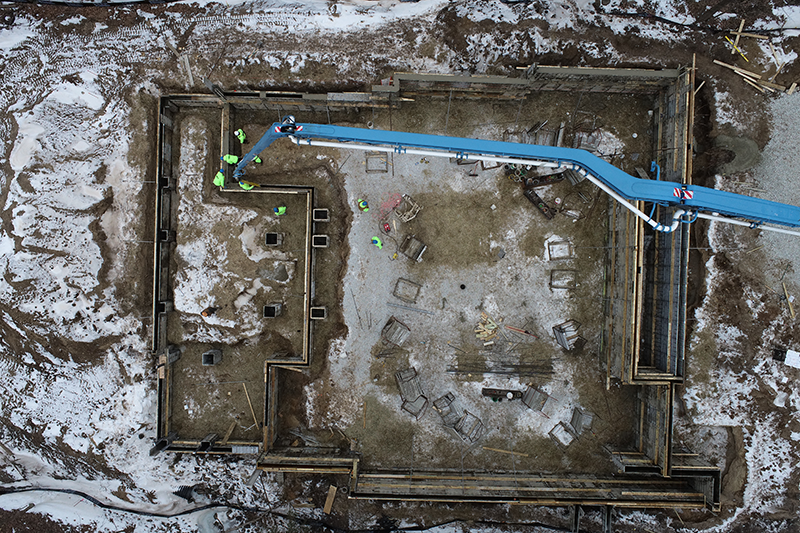
Tales of the Tape:
- Linear Feet of Wall: 614
- Square Feet: 4,370 (house) – 7,650 total (garage & porches)
- Yards of Concrete: 230
- Steel Reinforcement: 11,000 lbs.
- Wall Heights: 3′-4″ to 13’-0” (twelve heights)
- Wall Thickness: 10”, 12″ and 14”
This project had numerous steps in the footings due to soil conditions and its lakeside location along with taller than average wall heights. While mostly 10′ 0″ & 11′ 4″ walls, they reached as high as 13′-0″. Using modular aluminum forms, we were able to achieve this variety by stacking and using combinations of 5-ft , 4-ft, 2-ft, 6-ft, 8-ft and 9-ft forms. Given the prior experience on more complex jobs, we were able to participate in this project based on our reputation and deliver it with our attention to detail.
Among the complicated details, there was a dual-level back porch with one level for a hot tub and one level for seating. The wall detailing combined a stepping brick ledge along with a 16-in. deep floor joist interior ledge to facilitate a on-grade entrance for accessibility. The brick ledge stepped at 8-in., 1′-8″, 2′-8″, 3′-8″, 4′-8″, and 5′-8″). Finally, common to such large custom foundation structures, there were multiple, oversized window openings with treated wood bucks cast-in-place.
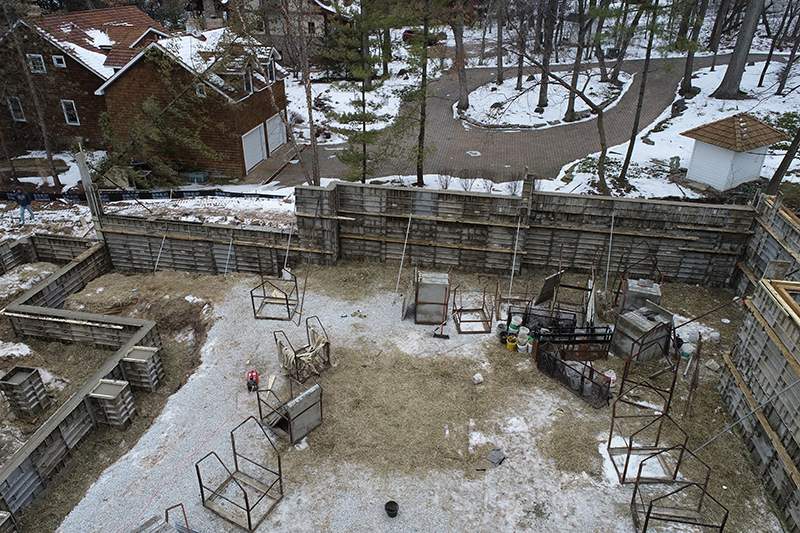
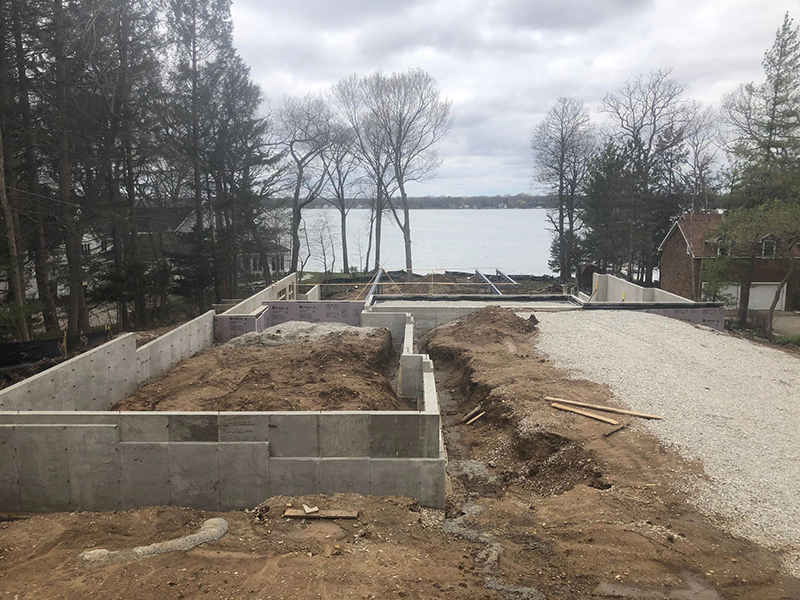
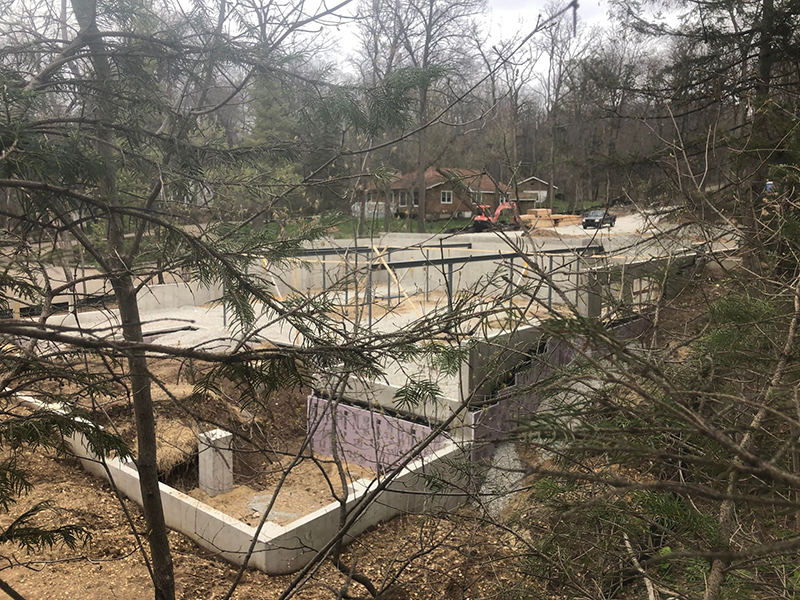
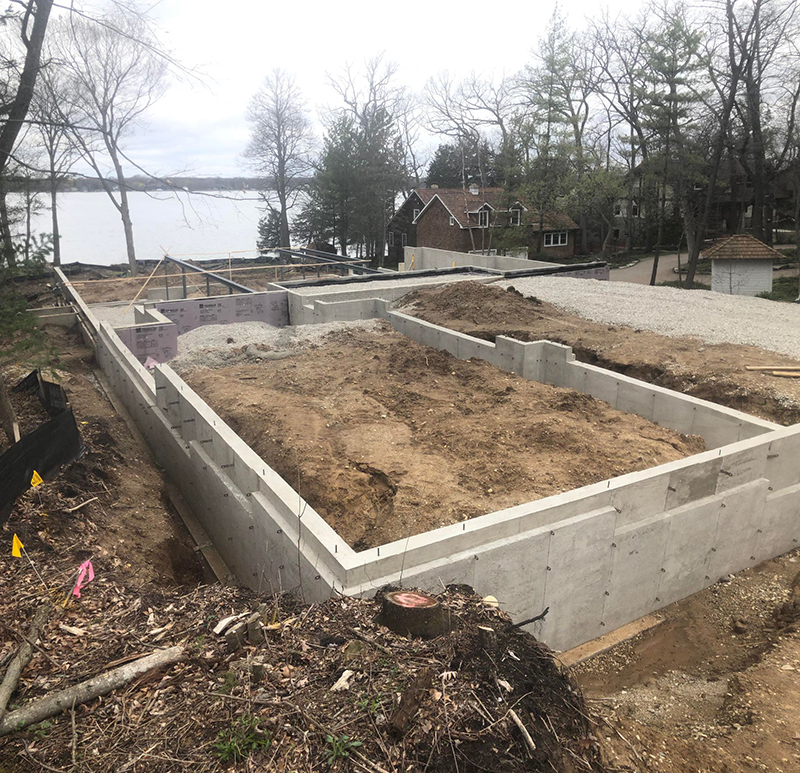
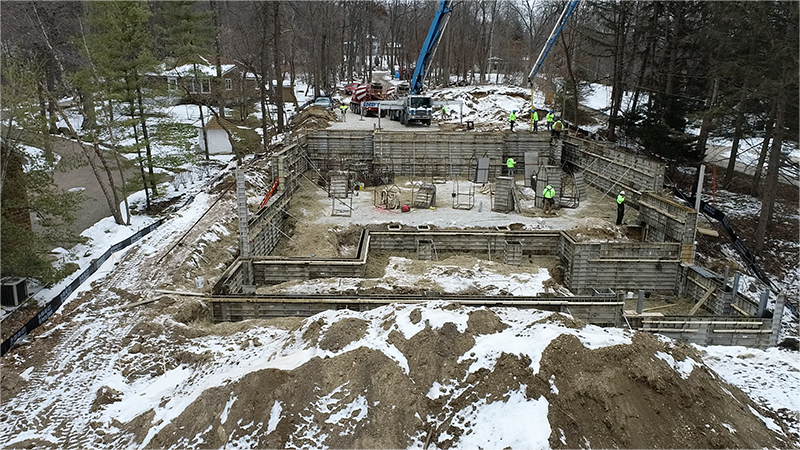
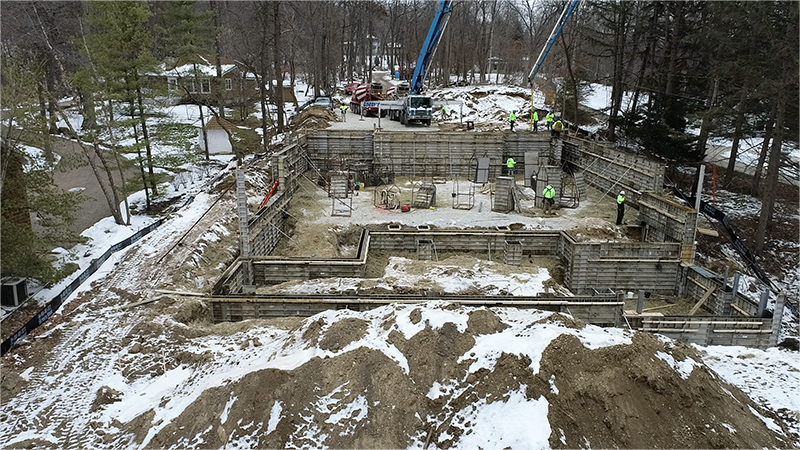
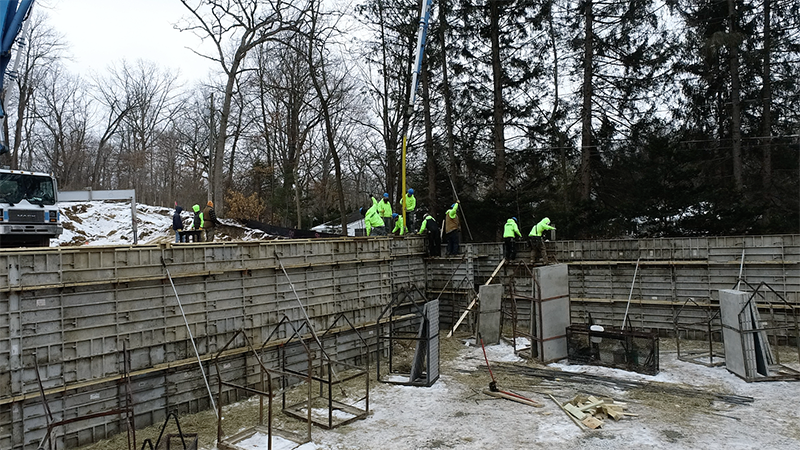
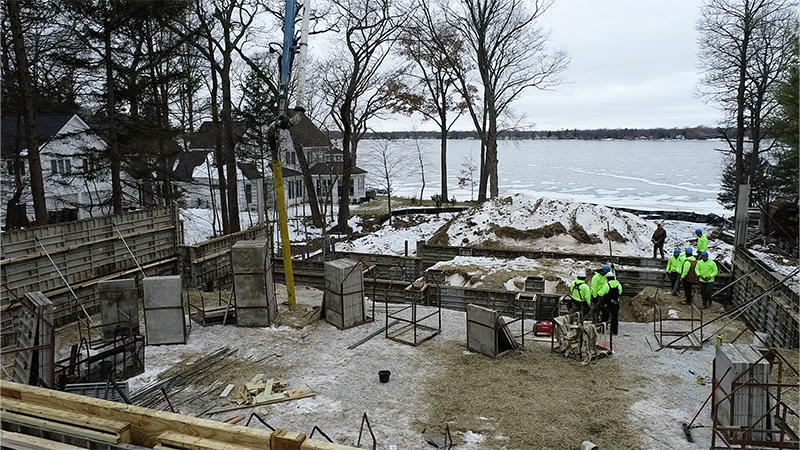
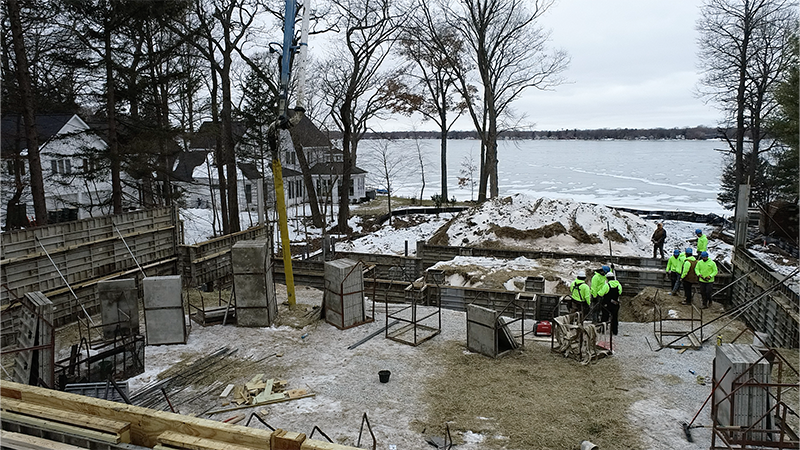
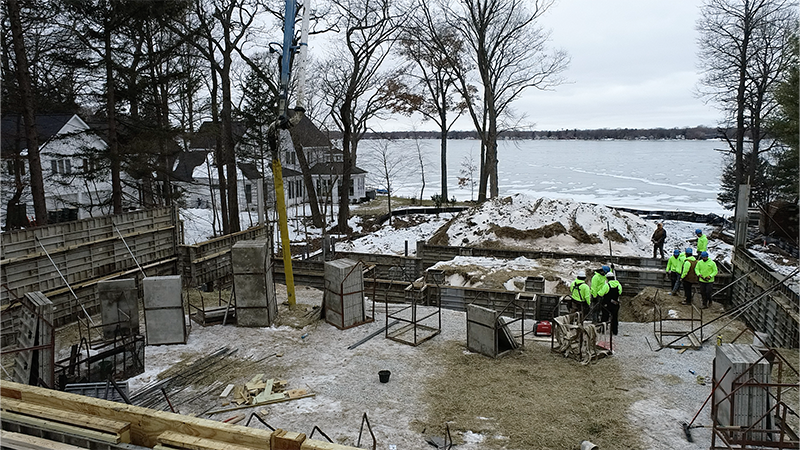
A phased approach to this project allowed our crews to work simultaneously on other projects with critical schedules. With the efficiency of our operations, all house footings were completed in two days and the walls in six days followed by the garage section with a day each for footings and walls, and finally the porch levels.
_________________________________________________________________________________
UNIQUE/SPECIAL PROJECTS: POOL FOUNDATION
CHAPIN CONCRETE CONTRACTORS INC.
River Bluff Pool Foundation | Chapin, South Carolina
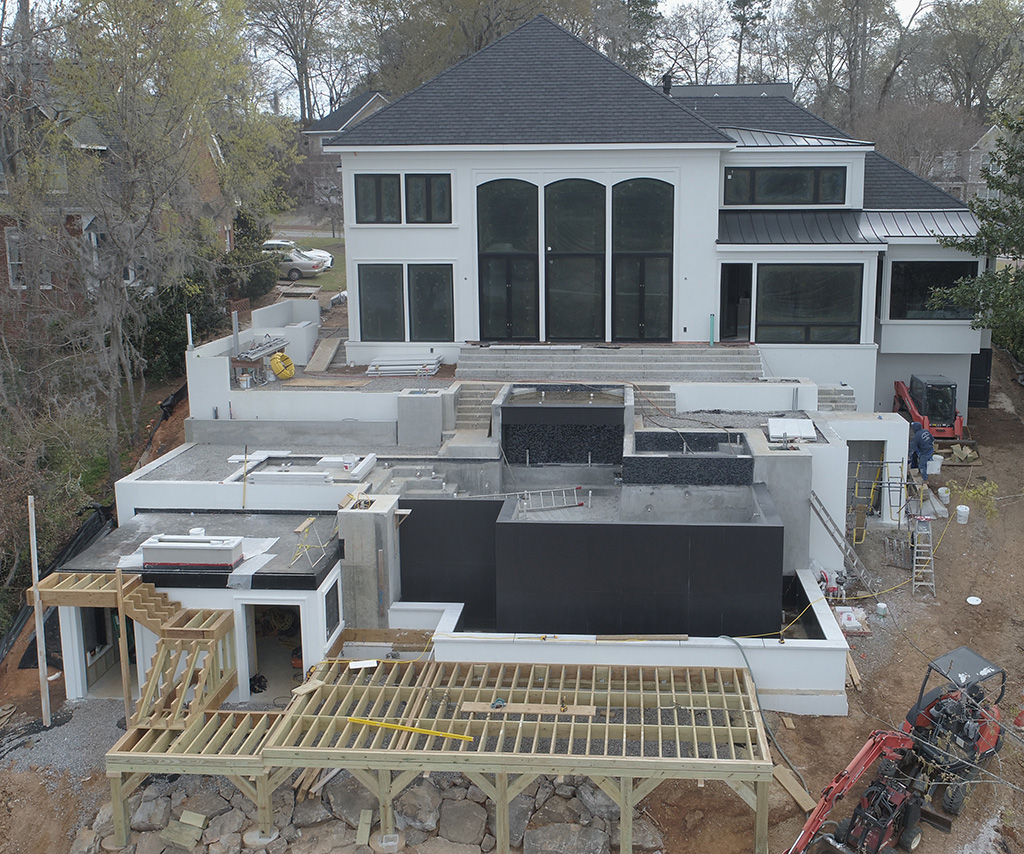
Tales of the Tape:
- Linear Feet of Wall: 425
- Square Feet: 2,345
- Yards of Concrete: 325
- Steel Reinforcement: 40,000 lbs.
- Wall Heights: 1’-0” to 16’-0”
- Wall Thickness: 8” to 20”
- Excavation Mass: 580 cubic yards
- Backfill: 780 tons of #57 stone
This project posed significant challenges not only from the complexity of the foundation work but also from the limited access and the extreme slopes we encountered. This project was constructed on a one-to-one slope. We managed to install a tremendous amount of foundation wall in a very small footprint. We met all the criteria for making a high-quality structure safely anchored into the slope—with zero incidents and virtually no rework or punch-list items to address at the end of the project.
We are extremely proud of all our efforts and the teamwork between our company, other
contractors, and the design professionals involved in this project. The project was so complex that an immense amount of the details had to be coordinated as we built the foundation. We spent hundreds of hours collaborating with everyone involved in the project. This was a once-in-a-career opportunity for our firm, and we are very pleased with our finished work. The success of this project is a testament to the hard work and dedication of our team.
_________________________________________________________________________________
ABOVE-GRADE CONCRETE HOME AWARD
TCB WALLS INC.
Nuvision Custom Homes | Melbourne, Florida
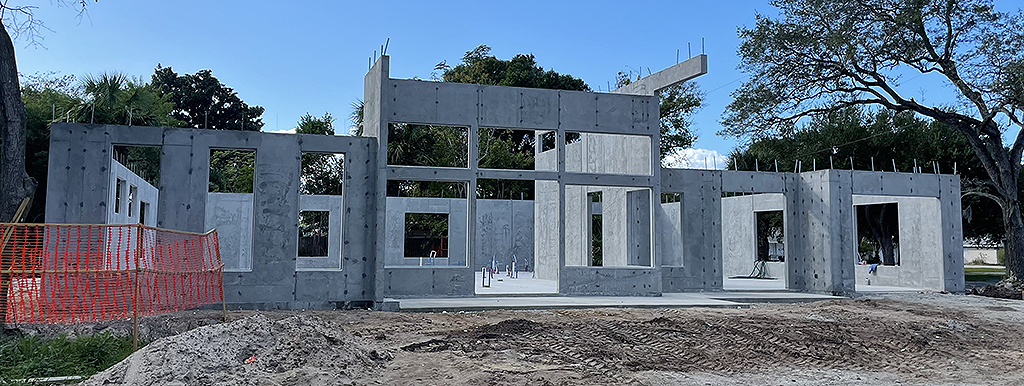
Tales of the Tape:
- Linear Feet of Wall: 301
- Square Feet: 4,217
- Yards of Concrete: 56
- Steel Reinforcement: 4,950 lbs. (bar) 7,560lbs. (Helix TSMR)
- Wall Heights: 10’-0”, 15-0” and 16’-9”
- Wall Thickness: 6” and 8”
This project had a very busy front elevation that seemed to catch everyone’s eye once forms were removed. Many windows were incorporated in the design, resulting in some very thin beams along with a cantilevered beam for the front porch. The design resulted in a “floating roof” with no columns, which gives the finished home a very unique appearance.
While certainly not the largest project we completed during the year, it has a noticeable look, and it nicely features some of the options and character that can be incorporated into an above-grade cast-in-place concrete structure.
_________________________________________________________________________________
UNDER 2K SINGLE-FAMILY RESIDENTIAL FOUNDATION AWARD
O’RISKY EXCAVATING
DHL Cabin | Evansville, Indiana
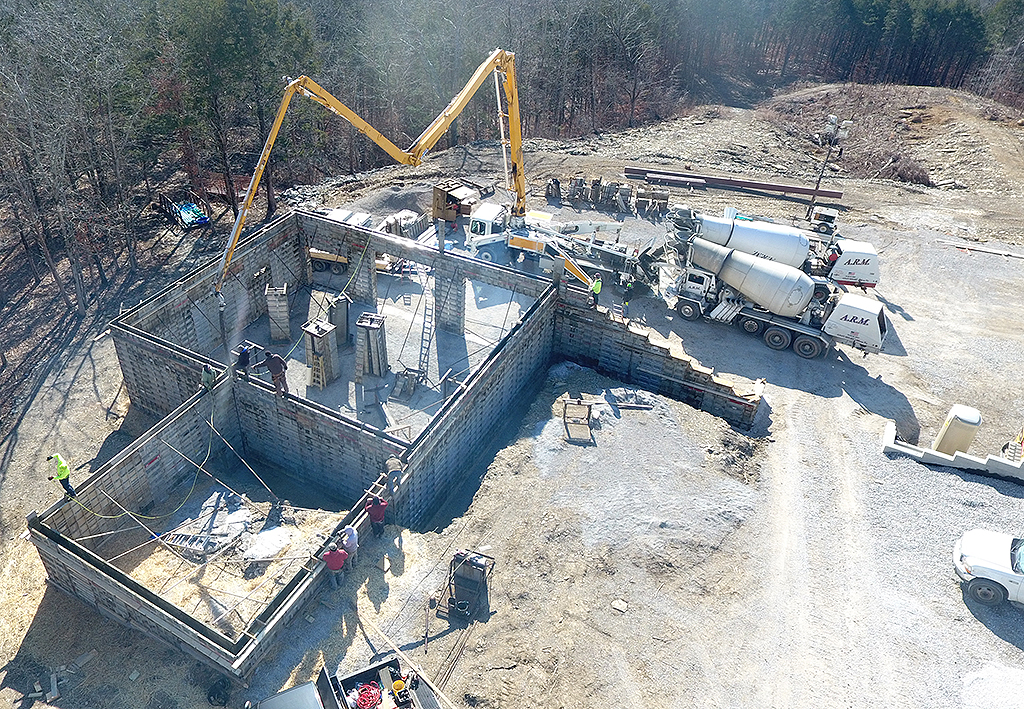
Tales of the Tape:
- Linear Feet of Wall: 300
- Square Feet: 1,920
- Yards of Concrete: 375
- Steel Reinforcement: 17,500 lbs.
- Wall Heights: 14’-0”
- Wall Thickness: 10”
- Steel Beams: 10,000 lbs.
- Excavation Mass: 10,000+ cubic yards
- Backfill: 5,000 lbs. of stone
This project, though small, had many challenges throughout. The difficult, rough terrain created multiple challenges, including a steep elevation change required to access the site from the county road. This made it necessary for us to produce a temporary concrete road with a rough, “boat ramp” finish to provide enough traction for construction equipment access.
The height of walls and the location were designed to maximize the view of the lake. The steep grade required multiple footing steps in the garage specifically. There was additional steel structural design to support hollow-core precast panels and hot-tub structure steel frame.
Our work gained the respect of local contractors and businesses who have worked and continue to work on this project, and this respect has been reciprocated.
_________________________________________________________________________________
MULTI-FAMILY/TOWNHOME AWARD
TCB WALLS INC.
Elbow Creek Townhomes | Melbourne, Florida
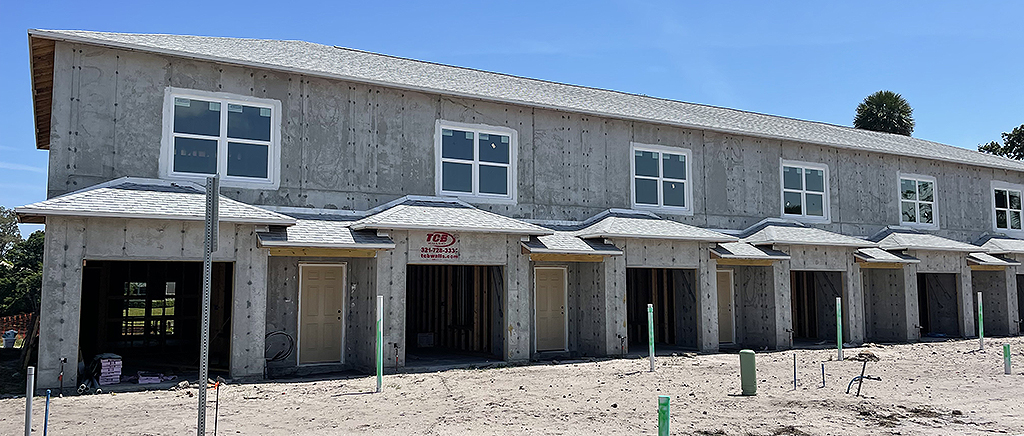
Tales of the Tape:
- Linear Feet of Wall: 3,120
- Yards of Concrete: 1,032
- Steel Reinforcement: 74,000 lbs. (bar)
- 11,127 lbs. (Helix TSMR)
- Wall Heights: 9’-0” and 20-0”
- Wall Thickness: 6” and 8”
This project is a great example of all that you can do with poured walls. We went from pouring a 9-foot-tall retaining wall to pouring 20-foot-tall townhome walls above it using all the same men and equipment. We were able to give this customer a much stronger structural frame than they could have with any other product, and we ended up with a very satisfied owner and general contractor, which is always our goal.
Access to this site was very limited with a river all along one side. The retaining wall was a priority for building up the rest of the property and supporting two of the seven-unit townhomes. They required 7-foot-wide footings with double-mat steel grids of #5 and #6 along and 48-inch dowels at 12-inch o.c.
_________________________________________________________________________________
UNIQUE/SPECIAL PROJECTS: RETROFIT/RENOVATION
TALPEY CONSTRUCTION
Gengras Cottage | Old Saybrook, Connecticut
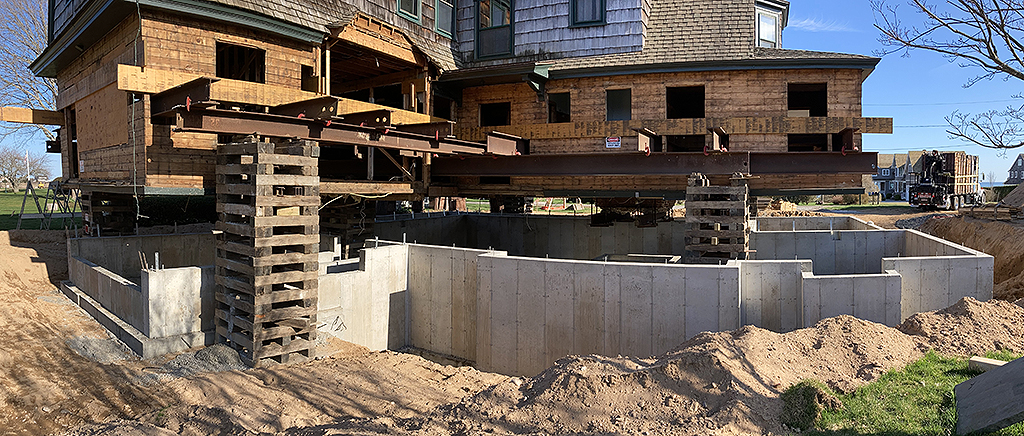
Tales of the Tape:
- Linear Feet of Wall: 400
- Square Feet: 3,000
- Yards of Concrete: 120
- Steel Reinforcement: 4,000 lbs.
- Wall Heights: 3’-10”, 5’-6”, and 8’-10”
- Wall Thickness: 8” and 10”
This project consisted of making a new foundation under a historic home that would also receive an addition. Footings were located off the existing house once it was jacked up. The new wing was added to the left side, and a big wraparound front porch and garage stepped up from the main house. Additionally, we had footings for column pads and a fireplace that could only be located in the field to match existing condition.
Working underneath a house is always tough. The crib piles are always closer than you’d like, the pours take extra planning because they take longer, and you are locked into whatever dimensions you pull off the existing house. This house also had a center fireplace that needed a foundation up underneath it—high enough for us to be able to make up the difference with a structural slab, low enough for the house lifter to be able to lower the structure without interference.
_________________________________________________________________________________
5K-15K SINGLE-FAMILY RESIDENTIAL FOUNDATION AWARD
WEBER CONCRETE CONSTRUCTION
Hussey Lane | Zionsville, Indiana
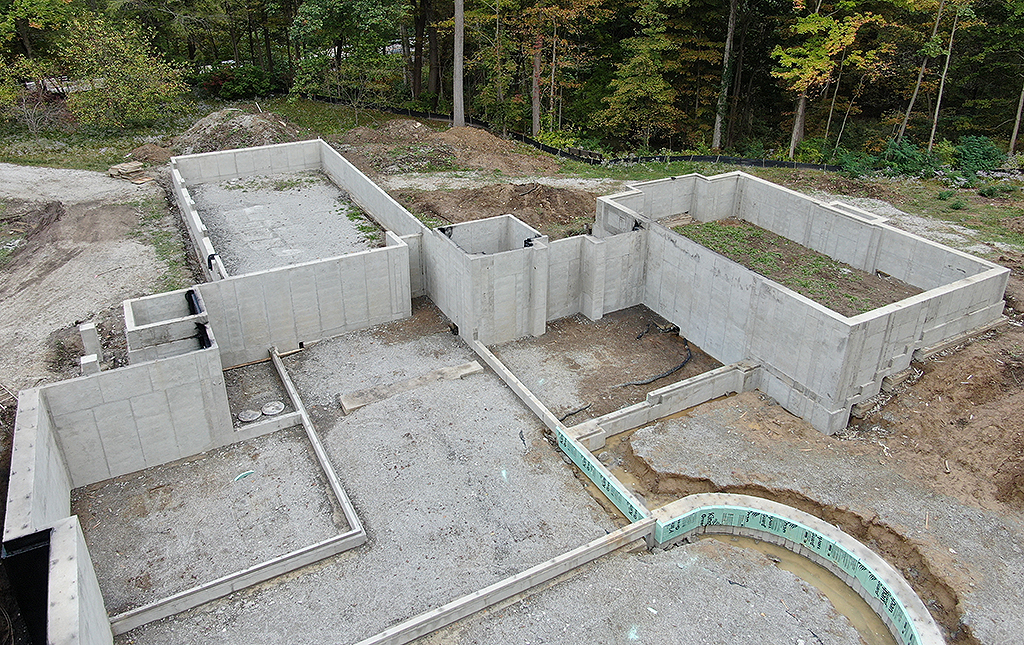
Tales of the Tape:
- Linear Feet of Wall: 2,672
- Square Feet: 8,569
- Yards of Concrete: 400
- Steel Reinforcement: 31,980 lbs.
- Wall Heights: 2’-0” to 13’-0” (six total)
- Wall Thickness: 8” to 22” (six total)
- Footing Sizes: 22” by 12” and 48” by 12”
Only a few homes are of estate caliber, and this was one of them. All big houses use large footings, unusual wall proportions, and special specifications for concrete. This was no different from those in other parts of the country, but very unique for our market. The beauty of this house, this estate, set on this lot with all the special features and finishes makes this one of our finest constructions.
The complexity of the project necessitated total organization and focus to ensure each measurement was exact. Our crews double- and triple-checked throughout the project and worked with the client’s engineer and architect throughout construction. This close attention began at the start of the project, where we had three people involved in estimating and detailing, checking each other’s work.
_________________________________________________________________________________
OVERALL GRAND PROJECT: OVER-15K SINGLE-FAMILY RESIDENTIAL FOUNDATION AWARD
SCW FOOTINGS & FOUNDATIONS
Sorensen Residence | Salt Lake City, Utah

Tales of the Tape:
- Linear Feet of Wall: 1,274
- Square Feet: 19,943
- Yards of Concrete: 768
- Steel Reinforcement: 33,066 lbs.
- Wall Heights: 4’-0” to 30’-0” (House)
- 3’-0” to 15’-0” (Garage)
- Wall Thickness: 8”, 10”, and 12”
The massive size of this project meant that we needed to pour the footings and foundations in several sections to accommodate the reach of the pump as well as our available forms to build. The layout spans 275 feet across and consists of 1,144 linear feet of foundation wall. There was a total of 82 in-wall rebar cages/columns to receive post-installed embeds. There was 175 linear feet of shelved foundation to accept a precast floor system above.
The job included 25 separate footing steps, totaling 57 feet in vertical grade changes.
Continuous footing sizes ranged from 24 to 48 inches wide and 12 inches thick with most pad footing sizes ranging from 48 to 156 square inches and 12 to 25 inches thick. One pad footing was 29 feet by 10 feet 6 inches, and although originally designed to be 20 inches thick, site conditions required this to be constructed to 36 inches thick.
PROYECTOS DEL AÑO DE 2022
English | Translation Provided by the CFA
ESTABLECER UNA CULTURA DE ORGULLO
El panorama norteamericano continúa ocultando las instalaciones de concreto más creativas y desafiantes cada año. Ahora en su 23er año, este programa continúa con su visión de dar voz y expresión a las grandes obras terminadas cada día en todos los mercados que sirven, apoyan y establecen el arte y la ciencia de la construcción residencial. Las compañías en toda la membresía han expresado el valor de tener proyectos que presentaron para un programa de premios. Reconoce a las cuadrillas involucradas e infunde orgullo en ellas por su logro. Cuando son seleccionados como uno de los proyectos singulares en una clase dada, estas compañías reconocen la importancia de conmemorar sus logros y compartir su agradecimiento con los clientes y colaboradores que confiaron en ellos para cumplir con el reto.
A principios de 2022, los miembros de la Asociación fueron una vez más invitados a considerar proyectos de sus carteras que sentían que representaban una mano de obra y calidad de construcción excepcionales, un logro inusual, una complejidad del proyecto e integración de tecnología progresiva para establecer un nuevo estándar. Estos criterios a menudo no se consideran en una industria donde el producto terminado es rápidamente cubierto a medida que se construye sobre él. Sin embargo, las compañías de vanguardia entienden el valor de mirar de cerca a fin de reconocer las soluciones de calidad producidas en el campo para el trabajo solicitado por el cliente, especificado por diseñadores y encargado por los constructores.
¿Qué se necesita para presentar un proyecto? La consideración principal implica la planificación, ya que se necesita la habilidad de describir los requisitos y los resultados, así como la documentación fotográfica o de video del desempeño. Con esto en mente, cualquier compañía puede aprovechar esta oportunidad de avanzar la cultura de su compañía y contribuir al avance de la industria.
Así que, sin más demora, la Concrete Foundations Association presenta los principales logros en proyectos de concreto de 2022, los Proyectos del Año de la CFA, que fueron entregados durante la #CFACON22, que se celebró en Boston, Massachusetts este pasado julio. Algunos son ganadores conocidos y algunos son nuevos lo que demuestra una vez más el panorama diverso de los tipos, tamaños, complejidad y experiencias de los proyectos.

_________________________________________________________________________________
PREMIO DE CIMIENTOS RESIDENCIALES EN CASAS UNIFAMILIARES DE 2 MIL A 5 MIL
SCW FOOTINGS & FOUNDATIONS
Whispering Hawk | Salt Lake City, Utah
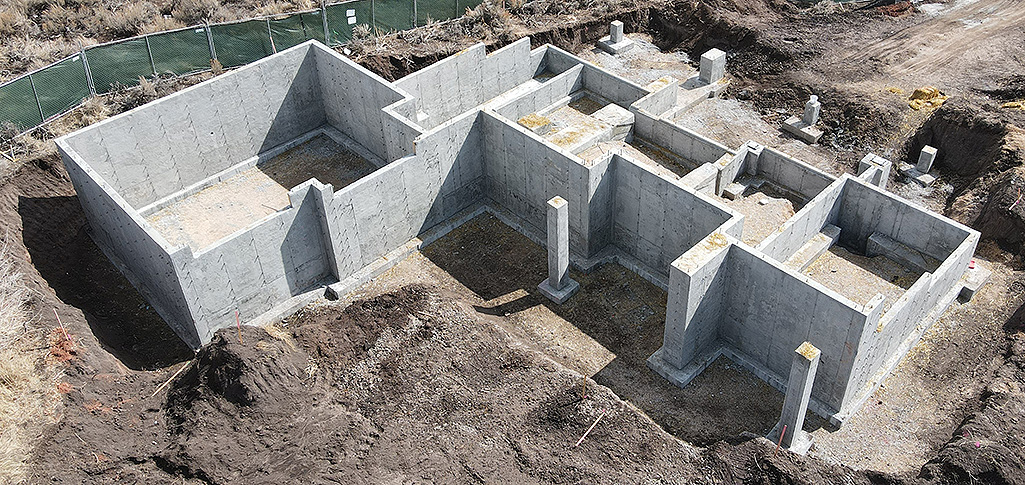
Datos del proyecto:
- Pies lineales de muro: 318
- Pies cuadrados: 4,120
- Yardas de concreto: 133
- Refuerzo de acero: 11,185 libras
- Alturas de muros: 4’-0” a 11’-0”
- Espesor de muros: 8” y 24”
Creemos que el éxito de cada proyecto comienza con el lanzamiento y la licitación. Nuestros estimadores y dibujantes de CAD contribuyen horas para asegurar la precisión y la rentabilidad para nosotros y el contratista. Ellos calculan todos los detalles y los programas de barras de refuerzo y simplifican los planes para la comunicación hacia y desde la obra. Los proyectos de este tipo pueden tardar semanas para terminarlos y el programa es fundamental para asegurar que no se descuiden otros trabajos.
El control y el aseguramiento de la calidad también son muy importantes. Los muros de 24 pulgadas de espesor y 11 pies de altura representan una mayor amenaza de fallas integrales que la mayoría de nuestros muros comunes. Las cuadrillas de campo verifican todos los tirantes, pasadores y cuñas antes de cualquier colocación del concreto para evitar fallas.
_________________________________________________________________________________
PROYECTOS SINGULARES/ESPECIALES: CIMIENTO PARA PISCINA
CHAPIN CONCRETE CONTRACTORS INC.
River Bluff Pool Foundation | Chapin, South Carolina

Datos del proyecto:
- Pies lineales de muro: 425
- Pies cuadrados: 2,345
- Yardas de concreto: 325
- Refuerzo de acero: 40,000 libras
- Alturas de muros: 1’-0” a 16’-0”
- Espesor de muros: 8” a 20”
- Masa de excavación: 580 yardas cúbicas
- Relleno: 780 toneladas de piedra #57
Este proyecto representó retos considerables no solo debido a la complejidad del trabajo de los cimientos, sino también debido al acceso limitado y las pendientes extremas que encontramos. Este proyecto se construyó en una pendiente uno a uno. Logramos instalar una tremenda cantidad de muros de cimientos en una huella muy pequeña. Cumplimos con todos los criterios para producir una estructura de alta calidad anclada con seguridad en la pendiente, con cero incidentes y prácticamente ningún retrabajo o elementos en la lista de pendientes para abordar al final del proyecto.
Estamos extremadamente orgullosos de todos nuestros esfuerzos y el trabajo en equipo entre nuestra compañía, otros contratistas y profesionales de diseño involucrados en este proyecto. El proyecto era tan complejo que una cantidad inmensa de los detalles tuvo que coordinarse a medida que construíamos la cimentación. Pasamos cientos de horas colaborando con todos los involucrados en el proyecto. Esto fue una oportunidad de una sola vez en la vida profesional para nuestra empresa y estamos muy complacidos con nuestro trabajo terminado. El éxito de este proyecto es testigo del arduo trabajo y dedicación de nuestro equipo.
_________________________________________________________________________________
PREMIO DE LA CASA DE CONCRETO POR ENCIMA DEL NIVEL DEL SUELO
TCB WALLS INC.
Nuvision Custom Homes | Melbourne, Florida

Datos del proyecto:
- Pies lineales de muro: 301
- Pies cuadrados: 4,217
- Yardas de concreto: 56
- Refuerzo de acero: 4,950 libras (barra)
- 7,560 libras (Helix TSMR)
- Alturas de muros: 10’-0”, 15-0” y 16’-9”
- Espesor de muros: 6” y 8”
Este proyecto tuvo una elevación frontal muy intensa que pareció atraer la atención de todos una vez que se quitaron los moldes. Se incorporaron muchas ventanas en el diseño, que resultó en algunas vigas muy delgadas a lo largo con una viga voladiza en el porche delantero. El diseñó resultó en un “techo flotante” sin columnas, que le aporta a la casa terminada una apariencia muy singular.
Aunque ciertamente no es el proyecto más grande que hemos completado durante este año, tiene una apariencia destacada e incluye algunas bellas opciones y carácter que pueden incorporarse en una estructura de concreto de colado en el lugar por encima del nivel del suelo.
_________________________________________________________________________________
PREMIO DE CIMIENTOS RESIDENCIALES EN CASAS UNIFAMILIARES MENORES A 2 MIL
O’RISKY EXCAVATING
DHL Cabin | Evansville, Indiana

Datos del proyecto:
- Pies lineales de muro: 300
- Pies cuadrados: 1,920
- Yardas de concreto: 375
- Refuerzo de acero: 17,500 libras
- Alturas de muros: 14’-0”
- Espesor de muros: 10”
- Vigas de acero: 10,000 libras
- Masa de excavación: Más de 10,000 yardas cúbicas
- Relleno: 5,000 libras de piedra
Este proyecto, aunque pequeño, tuvo muchos retos a lo largo de su construcción. El terreno difícil y escabroso creó varios retos, incluidos un cambio de elevación empinada necesaria para acceder al sitio desde la carretera rural. Esto requirió crear una carretera de concreto temporal con un acabado áspero “para rampa de embarcación” a fin de proporcionar suficiente tracción para el acceso del equipo de construcción.
La altura de los muros y la ubicación se diseñaron para maximizar la vista del lago. La pendiente empinada requirió varios escalones de zapatas específicamente en el garaje. Hubo un diseño estructural de acero adicional para sostener los paneles prefabricados huecos y el marco de acero estructural para el jacuzzi.
Nuestro trabajo se ganó el respeto de los contratistas y negocios locales que han trabajado
y continúan trabajando en este proyecto, y este respeto ha sido recíproco.
_________________________________________________________________________________
PREMIO DE CASA MULTIFAMILIAR/VIVIENDA EN SERIE
TCB WALLS INC.
Elbow Creek Townhomes | Melbourne, Florida

Datos del proyecto:
- Pies lineales de muro: 3,120
- Yardas de concreto: 1,032
- Refuerzo de acero: 74,000 libras (barra)
- 11,127 libras (Helix TSMR)
- Alturas de muros: 9’-0” y 20-0”
- Espesor de muros: 6” y 8”
Este proyecto es un gran ejemplo de todo lo que se puede hacer con muros vertidos. Pasamos de verter un muro de retención de 9 pies de altura a verter muros para viviendas en serie de 20 pies de altura por encima de ella usando los mismos trabajadores y equipo. Pudimos proporcionar a este cliente un marco estructural mucho más resistente de lo que hubieran podido obtener con cualquier otro producto y terminamos con un propietario y contratista general muy satisfechos, lo cual siempre es nuestro objetivo.
El acceso a este sitio era muy limitado debido a un río que corría a lo largo de uno de los lados. El muro de retención era una prioridad para construir el resto de la propiedad y sostener dos de las viviendas en serie de siete unidades. Estas necesitaban zapatas de 7 pies de ancho con mallas de acero de doble capa de #5 y #6 a lo largo y espigas de 48 pulgadas a 12 pulgadas desde el centro.
_________________________________________________________________________________
PROYECTOS SINGULARES/ESPECIALES: REDAPTACIÓN/RENOVACIÓN
TALPEY CONSTRUCTION
Gengras Cottage | Old Saybrook, Connecticut

Datos del proyecto:
- Pies lineales de muro: 400
- Pies cuadrados: 3,000
- Yardas de concreto: 120
- Refuerzo de acero: 4,000 libras
- Alturas de muros: 3’-10”, 5’-6” y 8’-10”
- Espesor de muros: 8” y 10”
Este proyecto consistió en construir una nueva cimentación debajo de una casa histórica que también sería ampliada. Las zapatas se ubicaron justo afuera de la casa existente una vez que se elevó. La nueva ala se agregó al lado izquierdo y un porche grande frontal envolvente y garaje se colocaron de manera escalonada desde la casa principal. Además, colocamos zapatas para las almohadillas de columnas y una chimenea que solo podía ubicarse en el campo para que coincidiera con las condiciones existentes.
Trabajar debajo de la casa siempre es difícil. Los depósitos siempre están más cerca de lo que usted cree, los vertidos requieren de planificación adicional porque toman más tiempo y usted está restringido a las dimensiones que obtuvo de la casa existente. Esta casa también tenía un chimenea central que necesitaba una cimentación debajo de ella, con la altura suficiente para que nosotros pudiéramos cubrir la diferencia con una losa estructural, suficientemente baja para que el levantador de la casa pudiera bajar la estructura sin interferencia.
_________________________________________________________________________________
PREMIO DE CIMIENTOS RESIDENCIALES EN CASAS UNIFAMILIARES DE 5 MIL A 15 MIL
WEBER CONCRETE CONSTRUCTION
Hussey Lane | Zionsville, Indiana

Datos del proyecto:
- Pies lineales de muro: 2,672
- Pies cuadrados: 8,569
- Yardas de concreto: 400
- Refuerzo de acero: 31,980 libras
- Alturas de muros: 2’-0” a 13’-0” (seis en total)
- Espesor de muros: 8” a 22” (seis en total)
- Tamaños de las zapatas: 22” por 12” y 48” por 12”
Solo algunas casas son de calibre de una finca y esta era una de ellas. Todas las casas grandes usan zapatas grandes, proporciones inusuales de muros y especificaciones especiales para el concreto. Esta no fue diferente de aquellas en otras partes del país, pero muy singular para nuestro mercado. La belleza de esta casa, esta finca, establecida en este terreno con todas las características y acabados especiales hace que sea una de nuestras mejores construcciones.
La complejidad del proyecto necesitó una organización y enfoque completos para asegurar que cada medida fuera exacta. Nuestras cuadrillas verificaron las medidas dos y tres veces a lo largo de proyecto y trabajaron con el ingeniero y el arquitecto del cliente durante toda la construcción. Esta atención estrecha comenzó al inicio del proyecto, donde tuvimos a tres personas involucradas en la estimación y los detalles que revisaban el trabajo unos de los otros.
_________________________________________________________________________________
PROYECTO GRANDE GENERAL: PREMIO DE CIMIENTOS RESIDENCIALES EN CASAS UNIFAMILIARES DE MÁS DE 15 MIL
SCW FOOTINGS & FOUNDATIONS
Sorensen Residence | Salt Lake City, Utah

Datos del proyecto:
- Pies lineales de muro: 1,274
- Pies cuadrados: 19,943
- Yardas de concreto: 768
- Refuerzo de acero: 33,066 libras
- Alturas de muros: 4’-0” a 30’-0” (casa)
- 3’-0” a 15’-0” (garaje)
- Espesor de muros: 8”, 10” y 12”
El tamaño enorme de este proyecto significó que necesitábamos verter las zapatas y cimientos en varias secciones para adaptar el alcance de la bomba, así como nuestros moldes disponibles para construir. La disposición se extiende a 275 pies a lo largo y consiste en 1,144 pies lineales de muros de cimientos. Hubo un total de 82 columnas/jaulas de barras de refuerzo dentro de muros para alojar las piezas empotradas después de la instalación. Hubo 175 pies lineales de cimientos almacenados para alojar el sistema de piso prefabricado en la parte superior.
El trabajo incluyó 25 escalones de zapatas, para un total de 57 pies en cambios de grado vertical. Los tamaños de las zapatas continuas variaron de 24 a 48 pulgadas de ancho y 12 pulgadas de espesor y la mayoría de los tamaños de las zapatas variaron de 48 a 156 pulgadas cuadradas y 12 a 25 pulgadas de espesor. Una zapata de almohadilla midió 29 pies por 10 pies 6 pulgadas y aunque fue diseñada originalmente para medir 20 pulgadas de espesor, las condiciones del sitio requirieron que se construyera para medir 36 pulgadas de espesor.
Concrete Foundations Association Drives Workforce Development as Advocate for the Trades
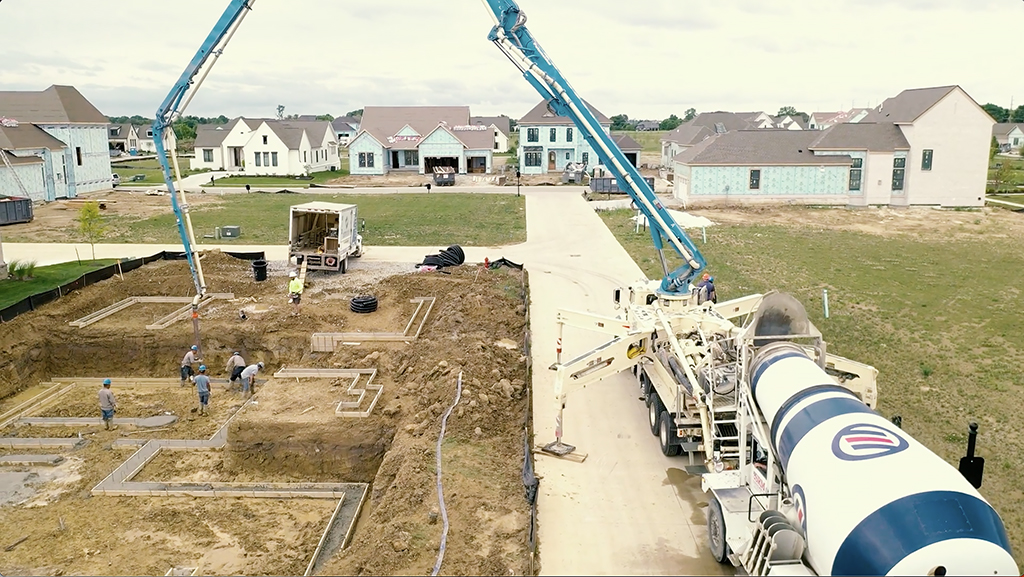
The Concrete Foundations Association (CFA) is excited to announce the completion of a national campaign designed to promote workforce development and career opportunities in the concrete construction industry.
CFA worked with Viewpoint, a unique educational platform, to develop the campaign.
For almost two decades the development team behind ViewPoint, with host Dennis Quaid, has been identifying key topics and issues found throughout the corporate and organization landscape that can be elevated to public awareness. Through a distribution model for Public Television, features are seen across the breadth of the U.S. television market.
“The Concrete Foundations Association has been developing a strategic approach to education and awareness of the needs and opportunities found in the trades,” states CFA Executive Director James Baty. “Many of our members have ongoing success building relationships and efforts for local and regional education outreach. This position became a strategic priority in 2020 to nationally recognize the great opportunities for careers in concrete construction. We are very pleased with the professionalism we have achieved with this ViewPoint partnership.”
The program has produced a variety of resources that span from public awareness to member promotion development kits. Beginning in November 2022, these products include:
- A CFA commercial to promote awareness of the Association and advocacy provided to be seen on national networks such as Fox Business News outwardly to an estimated 50 million households.
- A corporate profile awareness video to be seen on the Association’s website, Vimeo channel, World of Concrete Booth and promoted for use in local markets.
- A ViewPoint feature to begin airing on Public Television stations during programming breaks in December 2022 through the Fall of 2023. View this video here.
- Members-only access to a Promotion Development Kit for a customizable workforce development video, draft press release and education outreach strategies.
“This project was an exciting and engaging opportunity for the CFA,” states Jason Ells, Executive Vice President for Custom Concrete of Westfield, Ind. and current president for the Association. “Featuring key leaders in the industry, Association leaders and successes stories from the workforce, we were able to produce a message that some of the best careers await individuals that truly want to own their future and deliver it through a combination of working hard and alignment of their interest and skill set.”
Interested persons can learn more about the Concrete Foundations Association – ViewPoint partnership by visiting www.cfaconcretepros.org or looking for Concrete Foundations Association on Vimeo. Members can log in to their online account and access information about the Promotion Development Kit including the range of engagement options. For more information about this and other programs offered by the Association to its members, contact Skye Kelley at skelley@cfaconcretepros.org or by phone at 319-895-6940.
Una mentalidad anticuada no conduce a ideas nuevas 5 consejos para volverse más innovador al instante
English | Translation Provided by the CFA

Cuando realmente necesita una mentalidad o ideas nuevas o una solución creativa a un reto, un enfoque típico y cotidiano en su manera de pensar no es el proceso óptimo. Usar la misma vieja mentalidad simplemente lo llevará a las mismas ideas viejas que ya ha tenido o intentado en el pasado. En cambio, necesita hacer algo diferente que estimule su cerebro en diferentes maneras y cambie su perspectiva sobre los problemas en cuestión. Estas son algunas maneras para que usted (y su equipo) cambien su mentalidad de modo que puedan encontrar las ideas nuevas y frescas que necesita.
- Cambie su entorno. Salga de su sala de conferencias u oficina. Haga las reuniones de los resultados de una investigación más recientes o los reportes de la industria en un museo de arte. O bien lleve su equipo al zoológico con el objetivo de regresar con nuevas ideas. Según en qué parte del país se encuentre, puede enviar a sus equipos al Mall of America, Walt Disney World o a un área de moda de Manhattan para buscar inspiración e ideas nuevas.
Si no puede salir físicamente de la oficina, entonces busque una manera de salir de manera figurada. Pida a las personas que se imaginen cómo resolverían el problema en cuestión si vivieran en la Antártida o si vieran el problema desde la perspectiva de un capitán de submarino. - Invite a personas externas. Invite abiertamente a otras perspectivas a sus procesos de descubrimiento y generación de ideas. Por ejemplo, para un proyecto sobre nuevos envases e ideas de productos para una compañía de bebidas, invite a un diseñador de barcos, un experto en gestión de aguas pluviales, un escultor y un diseñador de parques acuáticos (entre otros). Su equipo de proyecto se asombrará con la variedad y diversidad de ideas nuevas pensadas cuando se exponen a nuevas perspectivas de su reto. Pensarán en ideas con las que estarán de acuerdo y que nunca hubieran pensado ellos solos, debido a sus propias suposiciones arraigadas sobre el tema.
- Involucre realmente a sus clientes. No dependa exclusivamente de los datos de segunda mano para entender las necesidades de sus clientes. Realmente debe hablar con ellos. Vaya a sus hogares u oficinas para ver los problemas para los cuales necesitan soluciones.
Muy a menudo los equipos que buscan un proyecto de generación de ideas dirán, “No necesitamos hacer ningún descubrimiento por adelantado porque ya tenemos muchos datos”. Esto lo debe poner en guardia, porque usualmente significa que tienen muchos reportes con montones de estadísticas sobre los clientes. Lamentablemente, en pocas ocasiones significa que han descubierto alguna perspectiva nueva y real sobre las necesidades del cliente.
Si está esperando que su equipo entienda al cliente con leer un montón de papeles o asistir a una presentación de PowerPoint, establezca el reto de buscar un proceso más atractivo e interactivo. Será mucho más efectivo sumergir a su equipo en un entendimiento real del cliente. - Cuestione todo. Haga algunos ejercicios que obliguen a las personas a enfrentar y desafiar sus suposiciones subconscientes sobre el tema. Una manera fácil de hacer esto es primero pedir ideas que el equipo cree que resolverían el problema, pero que probablemente no se puedan implementar debido a algún motivo. Luego, pídales que reestructuren cada idea al decir, “Es posible que podamos implementar esta idea SI…” Lo que viene después de los “si” ayudará a que surjan muchas suposiciones que tienen las personas que pueden o no ser realmente obstáculos. Por supuesto, algunos obstáculos resultarán ser reales, en cuyo caso, no invierta más tiempo en esas ideas. Pero en cada caso en el que hice esto con los equipos de clientes, también se descubrieron muchos supuestos obstáculos que en realidad podían superarse.
- Deje que las ideas descabelladas fluyan en la sala. La definición académica del pensamiento creativo es “el proceso de proponer ideas nuevas y útiles”. La manera principal de obtener ideas nuevas es comenzar con ideas aparentemente descabelladas. Cada idea realmente innovadora parece un poco descabellada al principio. Si empieza solo con ideas que son cómodas o claramente fáciles de implementar, probablemente no sean muy nuevas.
Así que anime a las personas a proponer ideas extremadamente disparatadas. Luego, juegue un juego llamado “Si pudiéramos”. Indique al equipo que dejen ir temporalmente los problemas de la idea y pregunte, “Si pudiéramos implementar esta idea, ¿cuáles serían los beneficios?” Después de identificar los beneficios de cada idea descabellada, redúzcalas a las más prometedoras y pida al equipo que busquen posibles soluciones a cualquier obstáculo.
Un equipo estaba a punto de descartar una idea realmente original para un nuevo cereal de niños debido a que no sabían cómo crear el componente crítico. Sin embargo, después del “Si pudiéramos”, acordaron que la idea era tan interesante y única que necesitaban explorarla. El equipo de investigación y desarrollo hizo algunas llamadas a otros expertos y luego de unas semanas, lo habían resuelto. ¡Esta idea resultó en el lanzamiento del producto nuevo más exitoso en la historia de la marca!
Lamentablemente, es demasiado fácil abordar cada reto nuevo usando nuestra mentalidad típica y cotidiana. Se siente familiar, es fácil de acceder a ese tipo de mentalidad y funciona en la mayoría de los retos diarios. Así que usted supone de manera subconsciente que funcionará con cualquier reto. Pero es increíblemente útil hacer un poco de metaanálisis de su mentalidad. Es decir, piense acerca de cómo está pensando. No todos los problemas se beneficiarán con el mismo tipo de mentalidad. Una vez que reconozca que esta nueva situación necesita una nueva mentalidad, es bastante fácil hacer algunas cosas a fin de cambiar a un modo más productivo para ese reto en particular. Luego regrese a la mentalidad más familiar y cotidiana para sus deberes diarios.
Old Thinking Won’t Lead to New Ideas 5 Tips to Instantly Become More Innovative
By Susan Robertson
Español | Translation Provided by the CFA

When you really need new ideas or fresh thinking or a creative solution to a challenge, a typical, day-to-day approach in your thinking is not the optimal process. Using the same old thinking will simply lead you to the same old ideas you’ve already had or tried before. Instead, you need to do something different—that will stimulate your brain in diverse ways and shift your perspective on the issues at hand. Here are some ways for you (and your team) to shake up your thinking so that you come up with the fresh, new ideas you need.
- Change your environment. Get outside your own conference room or office. Debrief the latest research results or industry report in an art museum. Or take your team to the zoo with the objective of coming back with new ideas. Depending on what part of the country you’re in, you could send your teams to the Mall of America, Walt Disney World, or a trendy area of Manhattan to look for inspiration and new ideas.
If you can’t physically get out of the office, then find a way to get out figuratively. Ask people to imagine how they would solve the problem at hand if they lived in Antarctica, or if they viewed the problem from the perspective of a submarine captain. - Bring outsiders in. Overtly invite other perspectives into your discovery and idea generation processes. For example, for a project on new packaging and product ideas for a beverage company, invite a boat designer, a rain-water management expert, a sculptor, and a water-park designer (among others). Your project team will be amazed at the range and diversity of new ideas that come when they are exposed to new perspectives on their challenge. They’ll think of ideas they’ll agree they never would have arrived at on their own, due to their own embedded assumptions about the topic.
- Truly engage with your customers. Don’t rely solely on second-hand data to understand your customers’ needs. You need to actually talk to them. Go to their homes or offices to see the problems for which they need solutions.
All too often teams looking for an idea-generation project will say, “We don’t need to do any discovery in advance because we already have lots of data.” This should make you wary, because it usually means they have numerous reports with reams of statistics about customers. Unfortunately, it rarely means they have discovered any real new insight into customer needs.
If you’re expecting your team to understand the customer by reading a deck or attending a Power Point presentation, challenge yourself to find a more engaging and interactive process. It will be far more effective to immerse your team in real customer understanding - Question everything. Do some exercises that force people to confront and challenge their subconscious assumptions about the topic. An easy way to do this is to first ask for ideas that the team thinks would solve the problem, but they probably couldn’t implement for some reason. Then, ask them to reframe each idea by saying “We might be able to implement this idea IF…” What comes behind the “ifs” will help surface a lot of assumptions people have that may or may not actually be barriers. Of course, some of the barriers will turn out to be real, in which case, don’t spend more time on those ideas. But in every case that I’ve done this with client teams, they also discover many supposed barriers that they could actually solve for.
- Let some crazy in the room. The academic definition of creative thinking is “the process of coming up with new and useful ideas.” The primary way to get new ideas is to start with seemingly crazy ideas. Every truly innovative idea seems a little crazy at first. If you only start with ideas that are comfortable or clearly easy to implement, they’re probably not very new.
So, encourage people to throw in extremely wild ideas. Then, play a game called “If We Could.” Instruct the team to temporarily let go of the idea’s problems and ask, “If we could implement this idea, what would be the benefit(s)?” Once you have identified the benefits of each crazy idea, narrow down to the most promising few and ask the team to look for possible solutions to any barriers.
A team was on the verge of killing a truly original idea for a new kids’ cereal because they didn’t know how to create the critical component. However, after “If We Could,” they agreed the idea was so interesting and unique that they needed to explore it. The R&D team made a few calls to other experts, and within a few weeks, they had solved it. This idea resulted in the most successful new product launch in the brand’s history!
It is, unfortunately, all too easy to approach every new challenge using our typical day-to-day thinking. It feels familiar, it’s easy to access that type of thinking, and it works on most daily challenges. So, you subconsciously assume it will work on any challenge. But it’s incredibly helpful to do some meta-analysis on your thinking. I.e., think about how you’re thinking. Not every problem will benefit from the same type of thinking. Once you recognize that this new situation needs new thinking, it’s fairly easy to do some things to shift to a more productive mode for that particular challenge. Then shift back to the more familiar day-to-day thinking for your daily tasks.
WALL FOREMAN QUALIFICATION SYLLABUS
Español | Translation Provided by the CFA
In 2020, the CFA Board of Directors created a Strategic Plan to focus Association energy for the next few years. This plan identified education as a primary need for field workers and a formalized plan to qualify training for the wall foreman as a key opportunity. Working with the World of Concrete, this course syllabus was developed to begin establishing professional development education for the concrete construction companies’ workforce. This syllabus outlines the process of and course options for earning a learning certificate designed to prepare individuals for the principal workforce category of wall foreman.
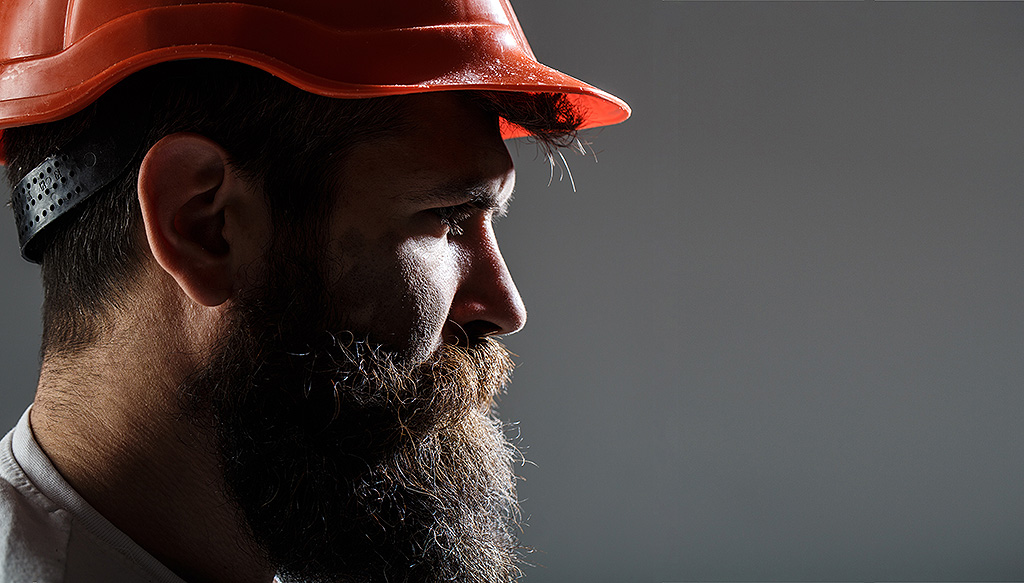
A wall foreman is described by the Concrete Foundations Association as the primary representative of the company for jobsite operations. Responsibilities include working with (or serving as) the project manager for residential foundation installations; directing all field crews from excavation through final site work (as applicable); managing material application, security, and efficiency; implementing and maintaining safety operations; being responsible for on-site equipment and operators; serving as “competent person” on-site for safety programming; and managing training operations for workforce development.
Goal: Establish a consistent set of courses delivered through national education programs, including the World of Concrete, the Concrete Foundations Convention, and virtual learning management systems.
Program Description:
During the World of Concrete 2023, the inaugural Wall Foreman Qualifications Certificate will be made available to registrants who achieve a total of 12 hours of qualifying education, as selected and authorized by the CFA in consort with the World of Concrete. This qualification process is aimed at preparing attendees to be considered for advancement to a wall foreman level of responsibility at the discretion of their employer.
Attendees registering for education during WOC 2023 will be required to take six hours of specified residential concrete construction courses presented by industry experts on Thursday, January 16. The three required courses are described below. In addition, attendees can select the remaining six hours of qualifying education from a pre-approved list of WOC seminars, including the optional four-hour ACI/CFA Residential Foundation Technician seminar (written exam will not be required unless candidate is seeking full certification).
Attendance will be verified at each session—show staff will scan badge credentials and each person’s attendance will be accumulated to ensure completion of the required 12 hours. Approximately three to four weeks after the end of WOC, the CFA will send a certificate to each verified attendee to show they completed the 12 hours of qualifying course work,
REGISTRATION: Available only through WOC 2023. To access the discount code from CFA Co-Sponsorship, use this custom link https://www.compusystems.com/servlet/ar?evt_uid=130&promocode=A30. Note: CFA Co-Sponsorship code includes discounted $25 for WOC Exhibits Only admission, if registering by 12/12/2022.
EDUCATION OFFERINGS: The following courses comprise the required and elective coursework options during the WOC 2023 for attaining the Wall Foreman Qualifications Certificate.
CFA REQUIRED COURSEWORK (three industry training courses for a total of six hours, Thursday Jan 19):
- Concrete Basics That Impact the Residential Concrete Industry – Joseph Daczko
[Session ID: CFA1] Thursday, January 19th (8:00–10:00 am
Concrete basics is a big part of the annual World of Concrete education, and there will be three concrete basics courses presented in 2023. Yet, none of them will really focus on the basics with regard to residential walls and what makes residential concrete different in expected quality and performance. This presentation will cover the current chemistry of the concrete mix and specifically focus on the three-legged stool performance of time, temperature, and humidity along with the basic internal risks or failure modes of plain concrete and what is being done about it. - Residential Wall Forming and Reinforcement Best Practices – Brent Anderson
[Session ID: CFA2] Thursday, January 19th (11:00 am–1:00 pm)
From removable forms to insulated concrete forms, today’s residential wall market has a broad spectrum of systems and applications. With each selection comes a different set of factors and best practices to be aware of for effective quality control and safety. Additionally, for reasons ranging from shrinkage crack control to engineered foundations for higher loading conditions, plain concrete must be reinforced in different ways to deliver good results. Once backfill is introduced to the foundation system, good decisions are rewarded and bad decisions magnified. - Finishing the Residential Foundation Wall for Performance: Curing to Drainage – Mike Hancock
[Session ID: CFA3] Thursday, January 19th (2:00–4:00 pm)
The finished wall with forms removed or left in place is not the end of the construction. The true performance—aesthetically, structurally, and in terms of moisture control—is largely decided by which curing practices are implemented, what the climate conditions are, the exposed nature of the finished surfaces, the selection of water barrier, and the installation and maintenance of drainage systems. Together, these will literally make or break a foundation wall with a lifetime of inconspicuous performance or perpetual troubleshooting.
ELECTIVES (select a total of six hours from WOC courses below):
- Residential Foundations: Compliance and Competency Review – James Baty
[Session ID: TU406] Tuesday, January 17th (8:00 am–12:00 pm) - Concrete Basics I: Concrete Materials, Mixtures & Fresh Properties – Jeff Groom, Rich Szecsy
[Session ID: MO01] Monday, January 16th (8:00 to 11:00 am) - Concrete Basics II: Ordering, Producing, Placing & Finishing Concrete – Jeff Groom,Rich Szecsy
[Session ID: MO02] Monday, January 16th (1:00 – 4:00 pm) - Concrete Basics III: Troubleshooting Typical Problems, Tips & Trends – Jeff Groom,
Rich Szecsy
[Session ID: TU03] Tuesday, January 17th (8:00 – 11:00 am) - Mix Design I: Evaluation of Mixtures – Ken Hover
[Session ID: WE04] Wednesday, January 18th (8:00 – 11:00 am) - Troubleshooting Concrete Cracks: Understand & Minimize Cracking – Kim Basham
[Session ID: MO06] Monday, January 16th (8:00 – 11:00 am) - Soft Skills for Hard Business – Wally Adamchik
[Session ID: MO11] Monday, January 16th (8:00 – 11:00 am) - Improving Performance Through Effective Leadership – Randy Anderson
[Session ID: TU13] Tuesday, January 17th (8:00 – 11:00 am) - How to Turn Inefficiency into Profitability – Brad Humphrey
[Session ID: WE14] Wednesday, January 18th (8:00 am – 11:00 am) - Preconstruction Checklist: Ensuring Project Success – Brian Birdwell, Rocky Geans
[Session ID: MO102] Monday, January 16th (10:30 am – 12:00 pm) - Fall Protection Best Practices: Industry Regulations & Guidelines – Tim Neubauer
[Session ID: MO103] Monday, January 16th (1:00 – 2:30 pm) - Boss to Leader: The Necessary Transition – Corey Adams
[Session ID: TU105] Tuesday, January 17th (8:30 – 10:00 am) - Strategic Tactical Productivity: Execution Techniques to Improve Field Project Results – Brad Humphrey
[Session ID: WE108] Wednesday, January 18th (1:30 – 3:00 pm) - How to Handle OSHA Inspections – Matt Murphy
[Session ID: TH109] Thursday, January 19th (8:30 – 10:00 am) - Troubleshooting Masonry: Cracks, Moisture and Efflorescence – Michael Schuller
[Session ID: TU115] Tuesday, January 17th (8:30 – 10:00 am) - What is Wrong with my Concrete? Troubleshooting Concrete Quality – Tyler Ley
[Session ID: MO124] Monday, January 16th (3:30 – 5:00 pm) - Cold Weather: Managing Concrete in Winter Conditions – Kim Basham
[Session ID: WE127] Wednesday, January 18th (8:30 – 10:00 am) - Hot Weather: Dealing with Concrete in Hot, Dry & Windy Conditions – Kim Basham
[Session ID: WE128] Wednesday, January 18th (1:30 – 3:00 pm) - Slump-Loss, Setting & Shrinkage: Concrete Won’t Wait! – Ken Hover
[Session ID: TH130] Thursday, January 19th (1:30 – 3:00 pm) - SPANISH – Concrete Basics I: Materials, Mixtures & Fresh Properties – Raul Bracamontes, Genaro Salinas
[Session ID: MOSP01] Monday, January 16th (8:00 – 11:00 am) - SPANISH – Concrete Basics II: Ordering, Producing, Placing & Finishing – Raul Bracamontes, Genaro Salinas
[Session ID: MOSP02] Monday, January 16th (1:00 – 4:00 pm) - SPANISH – Concrete Basics III: Problems, Tips & Trends – Raul Bracamontes, Genaro Salinas
[Session ID: TUSP03] Tuesday, January 17th (8:00 – 11:00 am) - SPANISH – Improve Leadership, Make Your Company More Competitive, & Increase Profitability – Federico Jasso
[Session ID: THSP08] Thursday, January 19th (1:30 – 3:00 pm)

